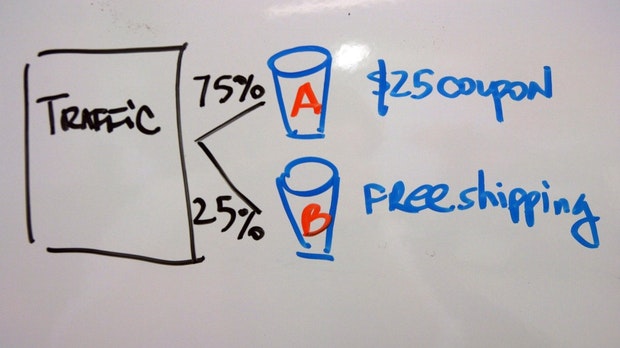We’ll show you what you should consider during A / B testing so that it doesn’t lead to problems from an SEO perspective.
Extensive A / B tests are an extremely important tool to increase the conversion rate. If you’re not careful, your test pages could have a negative impact on your SEO efforts. So that this doesn’t happen to you, we give you five tips to avoid any problems.
1. One page for the users, one for the Googlebot?
With today’s A / B test solutions, it shouldn’t be a problem anymore, but we would like to point out this danger to you. Based on the user agent, your server recognizes whether a visitor is a normal web surfer or a search engine bot. In order to get clean test results, you might be inclined to exclude the Googlebot from your test, for example, and to present it to another page – this technique is known as “cloaking”. However, Google explicitly wants to see what your visitors see. So if your A / B test solution does offer a possibility to use “cloaking”, you would do well not to use this function. In the end, you are only harming yourself.
2. But doesn’t Google index the wrong page?
You probably don’t want to find pages that you create exclusively for testing in the Google index. You have various options for this. For one, you could write the following two lines in your robots.txt file:
User-Agent: Googlebot
Disallow: /produkte/produkt-a-testseite.php
Alternatively, you can use a meta tag on the relevant page to specify that Google should not index the page. To do this, insert the following code into the meta tag in the header area of the website concerned:
name=“robots“ content=“noindex“
If you suspect that your test page has already landed in the index because you didn’t think about the previous steps, you can check it by searching for it in the following way and typing it into Google site:eureDomain.com/TestPage.php. Should it appear on Google, you can request the deletion of the URL via Google’s Webmaster Tools .

SEO: You can remove unwanted indexed test pages using Google’s Webmaster Tools.
3. The use of the canonical tag on your test pages
A / B testing different URLs can cause problems. From Google’s point of view, you put two almost identical websites online. Google could remove one of them from the index, after all, search engine users do not want to stumble upon identical content all the time. However, you should also tell Google which of the two pages you would like to keep in the index. To do this, you have to determine beforehand which of the pages it should be. The canonical tag is inserted into the other and refers to the “correct” page. To make sure you don’t make any mistakes, you should read our article ” SEO: The five most common mistakes with the canonical tag “.
4. Don’t just kick the losers in the bin
When you’ve completed your test and there is a clear winner, what should happen to the loser? If you delete the page including the images and videos used, this could be a disadvantage for you. After all, visitors could also come across your site via the image search, for example. If you delete the image, Google will remove it from the search index and you will lose potential visitors. It would therefore make more sense to leave the images on the server. A 301 redirect can be used for the actual page so that visitors are still directed to the winning page.
5. No A / B test should take too long
Your test should be ended when you have obtained a meaningful result. Even if you’re not exactly the math geeks, your testing tool should let you know in advance. If you let your test run too long, Google could see it as a manipulation attempt.
If we discover a site running an experiment for an unnecessarily long time, we may interpret this as an attempt to deceive search engines and take action accordingly. This is especially true if you’re serving one content variant to a large percentage of your users.
From the article Website testing & Google search on the Google Webmaster Central Blog
You shouldn’t let that scare you. You should never stop an A / B test prematurely. But if you have enough data, you should act on this information and adjust the test accordingly.
Conclusion: A / B testing and SEO
From an SEO perspective, there is no reason to be afraid of an A / B test. If you watch what you are doing, it will benefit you significantly more than it could even remotely harm you. If you need ideas for your tests, take a look at our article “ A / B test: 71 tips for more conversions ”.
